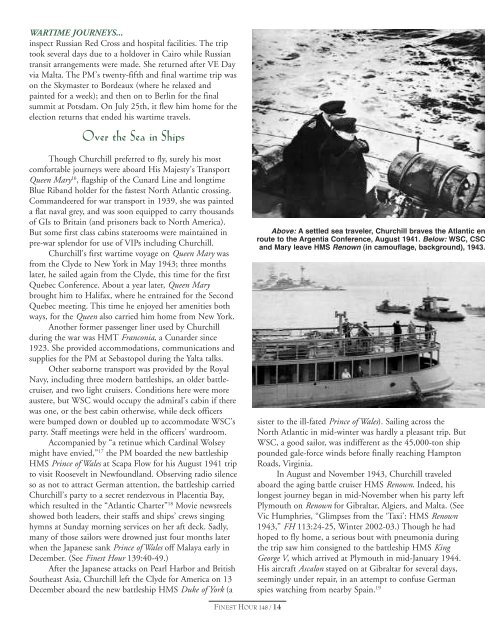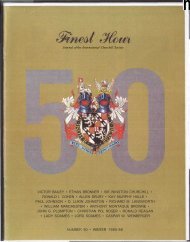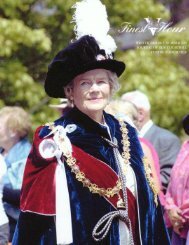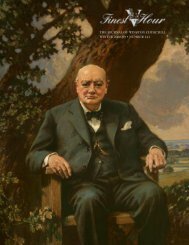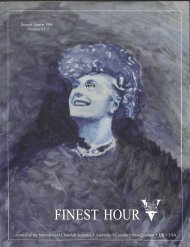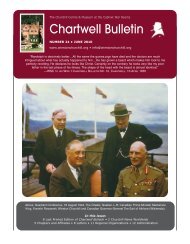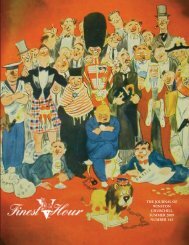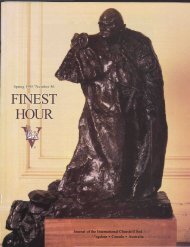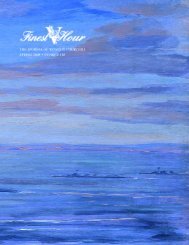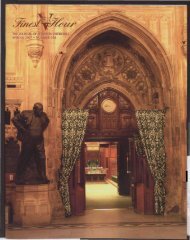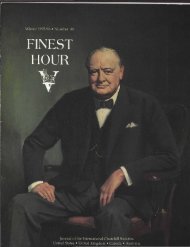Create successful ePaper yourself
Turn your PDF publications into a flip-book with our unique Google optimized e-Paper software.
WARTIME JOURNEYS...<br />
inspect Russian Red Cross and hospital facilities. The trip<br />
took several days due to a holdover in Cairo while Russian<br />
transit arrangements were made. She returned after VE Day<br />
via Malta. The PM’s twenty-fifth and final wartime trip was<br />
on the Skymaster to Bordeaux (where he relaxed and<br />
painted for a week); and then on to Berlin for the final<br />
summit at Potsdam. On July 25th, it flew him home for the<br />
election returns that ended his wartime travels.<br />
Over the Sea in Ships<br />
Though <strong>Churchill</strong> preferred to fly, surely his most<br />
comfortable journeys were aboard His Majesty’s Transport<br />
Queen Mary 16 , flagship of the Cunard Line and longtime<br />
Blue Riband holder for the fastest North Atlantic crossing.<br />
Commandeered for war transport in 1939, she was painted<br />
a flat naval grey, and was soon equipped to carry thousands<br />
of GIs to Britain (and prisoners back to North America).<br />
But some first class cabins staterooms were maintained in<br />
pre-war splendor for use of VIPs including <strong>Churchill</strong>.<br />
<strong>Churchill</strong>’s first wartime voyage on Queen Mary was<br />
from the Clyde to New York in May 1943; three months<br />
later, he sailed again from the Clyde, this time for the first<br />
Quebec Conference. About a year later, Queen Mary<br />
brought him to Halifax, where he entrained for the Second<br />
Quebec meeting. This time he enjoyed her amenities both<br />
ways, for the Queen also carried him home from New York.<br />
Another former passenger liner used by <strong>Churchill</strong><br />
during the war was HMT Franconia, a Cunarder since<br />
1923. She provided accommodations, communications and<br />
supplies for the PM at Sebastopol during the Yalta talks.<br />
Other seaborne transport was provided by the Royal<br />
Navy, including three modern battleships, an older battlecruiser,<br />
and two light cruisers. Conditions here were more<br />
austere, but WSC would occupy the admiral’s cabin if there<br />
was one, or the best cabin otherwise, while deck officers<br />
were bumped down or doubled up to accommodate WSC’s<br />
party. Staff meetings were held in the officers’ wardroom.<br />
Accompanied by “a retinue which Cardinal Wolsey<br />
might have envied,” 17 the PM boarded the new battleship<br />
HMS Prince of Wales at Scapa Flow for his August 1941 trip<br />
to visit Roosevelt in Newfoundland. Observing radio silence<br />
so as not to attract German attention, the battleship carried<br />
<strong>Churchill</strong>’s party to a secret rendezvous in Placentia Bay,<br />
which resulted in the “Atlantic Charter” 18 Movie newsreels<br />
showed both leaders, their staffs and ships’ crews singing<br />
hymns at Sunday morning services on her aft deck. Sadly,<br />
many of those sailors were drowned just four months later<br />
when the Japanese sank Prince of Wales off Malaya early in<br />
December. (See Finest Hour 139:40-49.)<br />
After the Japanese attacks on Pearl Harbor and British<br />
Southeast Asia, <strong>Churchill</strong> left the Clyde for America on 13<br />
December aboard the new battleship HMS Duke of York (a<br />
Above: A settled sea traveler, <strong>Churchill</strong> braves the Atlantic en<br />
route to the Argentia Conference, August 1941. Below: WSC, CSC<br />
and Mary leave HMS Renown (in camouflage, background), 1943.<br />
sister to the ill-fated Prince of Wales). Sailing across the<br />
North Atlantic in mid-winter was hardly a pleasant trip. But<br />
WSC, a good sailor, was indifferent as the 45,000-ton ship<br />
pounded gale-force winds before finally reaching Hampton<br />
Roads, Virginia.<br />
In August and November 1943, <strong>Churchill</strong> traveled<br />
aboard the aging battle cruiser HMS Renown. Indeed, his<br />
longest journey began in mid-November when his party left<br />
Plymouth on Renown for Gibraltar, Algiers, and Malta. (See<br />
Vic Humphries, “Glimpses from the ‘Taxi’: HMS Renown<br />
1943,” FH 113:24-25, Winter 2002-03.) Though he had<br />
hoped to fly home, a serious bout with pneumonia during<br />
the trip saw him consigned to the battleship HMS King<br />
George V, which arrived at Plymouth in mid-January 1944.<br />
His aircraft Ascalon stayed on at Gibraltar for several days,<br />
seemingly under repair, in an attempt to confuse German<br />
spies watching from nearby Spain. 19<br />
FINEST HOUR 148 / 14


